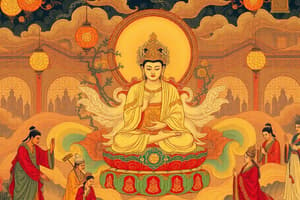Podcast
Questions and Answers
Which of the following is an accurate description of Samsāra in Early Buddhism?
Which of the following is an accurate description of Samsāra in Early Buddhism?
- A state of liberation achieved through ethical conduct and wisdom.
- The continuous cycle of birth, death, and rebirth driven by karma and ignorance. (correct)
- The original teachings of the Buddha before they were expanded upon.
- A collection of stories recounting the Buddha's past lives.
According to the principles of Karma in Early Buddhism, what role do intentions play in determining future rebirths?
According to the principles of Karma in Early Buddhism, what role do intentions play in determining future rebirths?
- Intentions are irrelevant; only the outcome of actions matters.
- Intentions are considered only in Mahāyāna Buddhism, not in Early Buddhism.
- Intentions matter significantly; actions driven by genuine generosity have different consequences than those driven by selfish reasons. (correct)
- Intentions are the primary factor, outweighing the actions themselves.
Which of the following statements best describes the role of the Jātaka Tales in Early Buddhism?
Which of the following statements best describes the role of the Jātaka Tales in Early Buddhism?
- They outline the monastic rules for the Sangha.
- They provide a detailed explanation of the concept of emptiness (Śūnyatā).
- They describe the path an enlightened individual takes in order to achieve Arhatship.
- They are moral stories recounting the Buddha's past lives, illustrating virtues like compassion and patience. (correct)
How does Mahāyāna Buddhism broaden the concept of the Sangha compared to Early Buddhism?
How does Mahāyāna Buddhism broaden the concept of the Sangha compared to Early Buddhism?
What is the significance of the Bodhisattva Path in Mahāyāna Buddhism?
What is the significance of the Bodhisattva Path in Mahāyāna Buddhism?
In Mahāyāna Buddhism, what does the concept of Śūnyatā (Emptiness) refer to?
In Mahāyāna Buddhism, what does the concept of Śūnyatā (Emptiness) refer to?
How do the Sūtras (teachings) differ between Early Buddhism and Mahāyāna Buddhism?
How do the Sūtras (teachings) differ between Early Buddhism and Mahāyāna Buddhism?
What is the ultimate goal in Theravāda Buddhism?
What is the ultimate goal in Theravāda Buddhism?
What is the significance of the Three Bodies Doctrine in Mahāyāna Buddhism?
What is the significance of the Three Bodies Doctrine in Mahāyāna Buddhism?
How do Theravāda and Mahāyāna Buddhism differ in their approach to achieving liberation?
How do Theravāda and Mahāyāna Buddhism differ in their approach to achieving liberation?
Flashcards
Buddha
Buddha
Enlightened teacher who discovered the path to liberation.
Dharma
Dharma
Teachings of the Buddha, including the Four Noble Truths and Eightfold Path.
Sangha
Sangha
Monastic and lay community that preserves and spreads the Buddha's teachings.
Samsāra
Samsāra
Signup and view all the flashcards
Karma
Karma
Signup and view all the flashcards
Jātaka Tales
Jātaka Tales
Signup and view all the flashcards
Arhatship
Arhatship
Signup and view all the flashcards
Bodhisattva Path
Bodhisattva Path
Signup and view all the flashcards
Early Buddhism and Mahāyāna
Early Buddhism and Mahāyāna
Signup and view all the flashcards
Nirvana
Nirvana
Signup and view all the flashcards
Study Notes
Major Concepts of Early Buddhism
- Early Buddhism is centered on individual liberation from suffering
- Liberation is achieved through self-discipline, ethical conduct, and wisdom
- Key concepts include the Three Jewels, Samsara, Karma, and Jataka Tales
- These concepts shape Buddhist practice and provide a path to Nirvana
Three Jewels: Foundation of Buddhism
- The Three Jewels (Buddha, Dharma, Sangha) guide Buddhist practice
- Buddha represents the enlightened teacher
- Dharma refers to the teachings, specifically the Four Noble Truths and Eightfold Path
- Sangha consists of monks, nuns, and lay followers who spread the teachings
- Practitioners commit to following the Buddhist path by taking refuge in the Three Jewels
Samsara: Concept of Rebirth
- Samsara describes the cycle of birth, death, and rebirth
- Karma sustains the cycle
- Ignorance and attachment also governs the cycle
- Nirvana is the only way to break free from the cycle
- Understanding Samsara motivates practitioners to cultivate wisdom and detach from worldly cravings
Karma: Moral Causation
- Karma or cause and effect plays a crucial role in Buddhist thought and practice
- Intentional actions determine future rebirths
- Acts of kindness, generosity, and mindfulness result in favorable outcomes
- Harmful actions lead to suffering
- It is not a fatalistic view, but a responsibility; individuals can choose their own destiny through ethical behavior
Jataka Tales: Buddha's Past Lives
- Jataka Tales recount Buddha's past lives before enlightenment
- Narratives exemplify compassion, patience, and self-sacrifice
- The Monkey King: Sacrifices himself to save his troop
- The Deer King highlights the virtue of non-violence and kindness
- Stories serve as moral lessons and encourage the cultivation of positive qualities
Early Buddhism vs. Mahayana Buddhism
- Theravada (Early) and Mahayana Buddhism share core ideas, but differ in goals, teachings, and practice
- Key differences include perspective on Arhat versus Bodhisattva, views of Nirvana, Sutras, and Metaphysics
Similarities: Shared Foundation
- Both accept core Buddhist teachings including the Four Noble Truths, Eightfold Path, Samsara, and Karma
- Importance of Sangha is also upheld
- Although both traditions seek to end suffering they attain Nirvana differently
- Mahayana integrates more lay participation within the Sangha
Key Differences: Arhat vs. Bodhisattva
- Theravada focuses on achieving Arhatship, a state of personal enlightenment
- Goal: End individual suffering to escape samsara
- In Mahavana; enlightened beings delay Nirvana to help all sentient beings by following the Bodhisattva Path
- This makes Mahayana more compassion-driven and therefore more accessible
- New metaphysical concepts include Sunyata (Emptiness) and the Three Bodies of the Buddha that go beyond the historical Buddha
Conclusion
- Both share common roots but diverge on their approach to enlightenment
- Theravada focuses on an individuals liberation
- Mahayana seeks universal salvation through compassion and wisdom
- Differences shape Buddhism traditions across Asia and still influence modern practice.
Studying That Suits You
Use AI to generate personalized quizzes and flashcards to suit your learning preferences.




